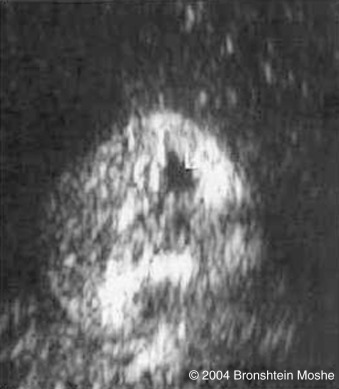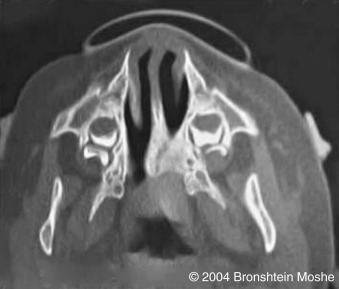Abstract
Choanal atresia is a congenital obstruction of the posterior nasal apertures. It is a very rare condition usually associated with syndromes and diagnosed postnatally. Prenatal diagnosis is very difficult, but choanal atresia can be suspected in the presence of nasal septal deviation or single nostril.
Keywords
choanal atresia, nasal obstruction, nasal septal deviation, single nostril
Introduction
Congenital choanal atresia is an uncommon condition resulting from a failure of the oronasal membrane to break down. Prenatal diagnosis of choanal atresia is rarely described, and postnatal confirmation is required. However, this condition can be suspected in the presence of nose anomalies, mainly if other fetal anomalies are present.
Disease
Definition
Choanal atresia is a congenital obstruction of the posterior nasal apertures.
Prevalence and Epidemiology
Choanal atresia is an uncommon condition with an estimated prevalence of 0.5 : 10,000 to 3 : 10,000 live births.
Etiology and Pathophysiology
Choanal atresia results from a failure of the breakdown of the wall between the nasal pits and the stomodeum in early embryogenesis. Historically, 90% of atresias have been described as bony, whereas the remaining 10% are membranous. More recent literature suggests that mixed membranous-bony atresias are more common, occurring up to 70% of the time. The condition can be unilateral or bilateral; in unilateral cases, the condition may not be detected until after the early neonatal period. Associated anomalies occur in about 50% of patients with some having recognized syndromes, including CHARGE ( c oloboma, h eart disease, choanal a tresia, r etardation, g enital hypoplasia, and e ar anomalies) syndrome, 9p monosomy, Crouzon syndrome, and Marshall-Smith syndrome. When choanal atresia is not associated with other defects, it is likely a multifactorial trait; however, a recessive or dominant transmission of the defect was described in several patients. An association with methimazole exposure in utero also was reported. Choanal atresia per se is of mild clinical relevance, and the prognosis depends on the underlying syndrome.
Manifestations of Disease
Clinical Presentation
The clinical presentation and diagnosis of choanal atresia is usually postnatal. Bilateral atresias can manifest with neonatal respiratory distress because infants are obligate nose breathers. Another finding is inability to pass a nasogastric tube. Unilateral choanal atresias may manifest late in life and can be asymptomatic, or manifest with rhinorrhea.
Imaging Technique and Findings
Ultrasound.
Prenatal ultrasound diagnosis is rare, and very few cases have been reported in the literature. Choanal atresia can be suspected prenatally in the presence of nose anomalies, mainly nasal septal deviation or the presence of a single nostril ( Fig. 67.1 ).

Magnetic Resonance Imaging.
Postnatal magnetic resonance imaging and computed tomography are the gold standard imaging techniques for diagnosis of choanal atresia. The characteristic feature is a unilateral or bilateral posterior nasal narrowing with an obstruction ( Fig. 67.2 ).











